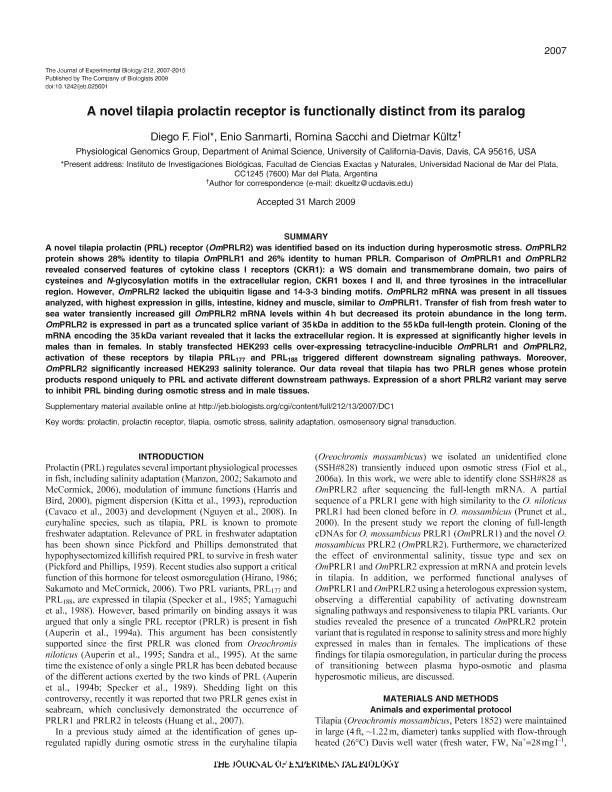Artículo
A novel tilapia prolactin receptor is functionally distinct from its paralog
Fecha de publicación:
06/2009
Editorial:
Company of Biologists
Revista:
Journal of Experimental Biology
ISSN:
0022-0949
Idioma:
Inglés
Tipo de recurso:
Artículo publicado
Clasificación temática:
Resumen
A novel tilapia prolactin (PRL) receptor (OmPRLR2) was identified based on its induction during hyperosmotic stress. OmPRLR2 protein shows 28% identity to tilapia OmPRLR1 and 26% identity to human PRLR. Comparison of OmPRLR1 and OmPRLR2 revealed conserved features of cytokine class I receptors (CKR1): a WS domain and transmembrane domain, two pairs of cysteines and N-glycosylation motifs in the extracellular region, CKR1 boxes I and II, and three tyrosines in the intracellular region. However, OmPRLR2 lacked the ubiquitin ligase and 14-3-3 binding motifs. OmPRLR2 mRNA was present in all tissues analyzed, with highest expression in gills, intestine, kidney and muscle, similar to OmPRLR1. Transfer of fish from fresh water to sea water transiently increased gill OmPRLR2 mRNA levels within 4h but decreased its protein abundance in the long term. OmPRLR2 is expressed in part as a truncated splice variant of 35kDa in addition to the 55kDa full-length protein. Cloning of the mRNA encoding the 35kDa variant revealed that it lacks the extracellular region. It is expressed at significantly higher levels in males than in females. In stably transfected HEK293 cells over-expressing tetracycline-inducible OmPRLR1 and OmPRLR2, activation of these receptors by tilapia PRL177 and PRL188 triggered different downstream signaling pathways. Moreover, OmPRLR2 significantly increased HEK293 salinity tolerance. Our data reveal that tilapia has two PRLR genes whose protein products respond uniquely to PRL and activate different downstream pathways. Expression of a short PRLR2 variant may serve to inhibit PRL binding during osmotic stress and in male tissues.
Palabras clave:
osmotic stress
,
prolactin receptor
,
tilapia
Archivos asociados
Licencia
Identificadores
Colecciones
Articulos(IIB)
Articulos de INSTITUTO DE INVESTIGACIONES BIOLOGICAS
Articulos de INSTITUTO DE INVESTIGACIONES BIOLOGICAS
Citación
Fiol, Diego Fernando; Sanmarti, Enio; Sacchi, Romina; Kultz, Dietmar; A novel tilapia prolactin receptor is functionally distinct from its paralog; Company of Biologists; Journal of Experimental Biology; 212; 13; 6-2009; 2007-2015
Compartir
Altmétricas




